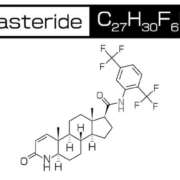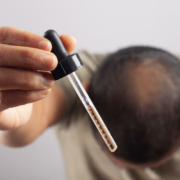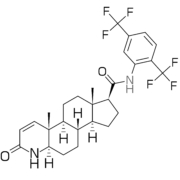How to Avoid Side Effects from Finasteride

If you’ve seen television ads for any medication, you know that almost all of them have potential side effects. By the time the announcer gets to the end of the (sometimes very long) list, you’re probably wondering why doctors even prescribe the medication in the first place. But, of course, some medications have more side effects than others. And, some medications get a bad rap just because one or two out of thousands had unusual reactions.
Fast forward to Finasteride. Finasteride, also known as Propecia or Proscar, is often prescribed to treat hair loss due to various conditions. Finasteride was originally marketed to treat men with enlarged prostates. During drug trials, doctors noticed that men who took Finasteride as a prostate treatment experienced hair growth. Finasteride was then FDA-approved to treat hair loss too. In this case, the side effect was a good one. However, some male Finasteride users have reported some undesirable sexual side effects. Should you be concerned? Not really. The side effects aren’t typical. Plus, there are ways to avoid the side effects if that’s a concern. We’re here to share why you shouldn’t worry if your doctor has prescribed Finasteride to treat your hair loss.
Why is Finasteride Prescribed for Hair Loss?
Finasteride is what’s called a DHT blocker. DHT is an acronym for dihydrotestosterone, which is an androgen, a male sex hormone. When men and women experience androgenetic alopecia, an enzyme called 5-alpha-reductase converts testosterone to DHT. When this happens, DHT can bind to the receptors on your hair follicles, shrinking the follicles during a process called miniaturization. Over time, the anagen phase of the hair growth cycle is reduced. The result is hair that is shorter and thinner. Eventually, new hairs become so small that they can’t penetrate the hair follicle. As a DHT blocker, Finasteride prevents this process from happening, so you maintain your existing hair and continue to grow healthy new hair.
What Hair Loss Conditions Does Finasteride Treat?
Oral Finasteride is FDA approved to treat androgenetic alopecia, male and female pattern hair loss. Male and female pattern hair loss is the most prevalent type of alopecia worldwide. There isn’t a way to predict who will experience pattern hair loss. The condition is genetic and can be inherited from either the maternal or paternal sides of the family. There isn’t a specific test to diagnose androgenetic alopecia. Dermatologists and hair specialists can make the diagnosis by evaluating a patient’s hair loss pattern.
Finasteride is also used to treat other types of alopecia, including alopecia areata and lichen planopilaris, which are caused by autoimmune conditions. However, the prescription is considered off label when prescribed to treat hair loss other than androgenetic alopecia.
Is Finasteride Effective in Preventing Hair Loss and Stimulating Growth
If you’re wondering whether Finasteride is worth the risk of whatever side effects could occur, that’s a valid question. Although deciding whether to use Finasteride is highly personal, research indicates that Finasteride is highly effective in promoting growth and preventing further hair loss. Over 80 percent of men who use Finasteride see improvement, and over 65 percent see new hair growth. Not only that, the results are long-term. A study of 1879 men indicates that hair count present after one year was maintained during the second year of treatment.
What are Finasteride’s Side Effects?
Side effects caused by oral Finasteride are usually mild and disappear after you stop taking the medicine. Here are a few signs to watch:
- Anxiety
- Depression
- Dizziness
- Weakness
- Headache
- Inability to urinate
- Testicular pain
- Runny nose
- Rash, itching, swelling of the face, lips, or tongue, or other signs of an allergic reaction
- Swelling of your hands or feet
Although these side effects aren’t exactly desirable, they aren’t most mens’ biggest fear. Most are more concerned about potential sexual side effects such as:
- Decreased libido
- Erectile dysfunction
- Decreased semen volume
- Breast enlargement & tenderness
- Premature ejaculation
The good news is that these side effects aren’t common. Some men who do experience the sexual side effects find that their symptoms disappear over time as their bodies acclimate to the medication. If not, discontinuing the use of Finasteride usually resolves the issue.
How Common are Side Effects from Finasteride?
As mentioned previously, side effects from Finasteride aren’t common. The main reason is that the dosage typically prescribed to treat alopecia is usually very low, much lower than the dosage prescribed for prostate treatment. As a matter of fact, only 3.8 percent of men who took Finasteride experienced side effects during the drug’s clinical trials. That’s compared to 2.1 percent of men who took a placebo.
Want to Avoid Finasteride Side Effects? Use Topical Finasteride Instead
If you’re still a little worried about using Finasteride, even though the risk of side effects is low, there’s a simple solution. Use topical Finasteride instead of oral Finasteride. The topical solution has been proven to be just as effective in treating male and female pattern baldness without the same risk of side effects. Whereas oral Finasteride is metabolized in your stomach, topical Finasteride is not systemic. Even better, topical Finasteride has less impact on serum DHT concentrations. Think of it as a highly effective spot treatment for your hair.
Research also indicates that combining Minoxidil with Finasteride yields even better results than using either medication alone. Adverse reactions among patients were rare, indicating that the combined medication is not only a good choice, but a preferable one.
Are You a Good Candidate for Finasteride?
Finasteride is often prescribed to both men and women to treat androgenetic alopecia. The medication is generally safe for most people. There are some exceptions though. Finasteride is not recommended if you have kidney problems, prostate cancer, liver disease, or any other liver-related issues. The medication is also not recommended to women who are pregnant, trying to get pregnant, or are breastfeeding.
What Should You Do if you Experience sexual or Other Side Effects from Finasteride?
If you think Finasteride is causing side effects, stop taking the medication and contact your dermatologist. The side effects usually go away after the medication is out of your system. However, you’ll want to work with your dermatologist to identify a substitute.
When considering a new medication, it’s important to do your research and feel confident about your choice. Finasteride is no exception. If you have questions and are looking for answers, we’re here to help. Our board-certified dermatologists and hair specialists look forward to giving you the information you need, when you need it, to get the healthiest, most effective hair loss treatment.
Resources:
(01) https://pubmed.ncbi.nlm.nih.gov/9951956/
(02) https://pubmed.ncbi.nlm.nih.gov/9951956/
(03) https://pubmed.ncbi.nlm.nih.gov/34634163/#:~:text=Conclusion%3A%20Topical%20finasteride%20significantly%20improves,impact%20on%20serum%20DHT%20concentrations.
(04) https://pubmed.ncbi.nlm.nih.gov/32166351/











